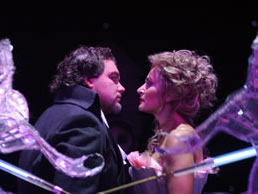

![]()
Opera Review by Karren LaLonde Alenier
|
Poet
Andrea Chenier meets Maddalena de Coigny
|
|
 |
|
|
Review of Andrea Chenier On September 11, 2004 preceded by a call for a silent moment and the singing of "The Star Spangled Banner" for those who died in the terrorist attacks on the World Trade Center, the Pentagon, and a field in Pennsylvania which could have been 1600 Pennsylvania Avenue, Washington National Opera opened its 2004-2005 season with Umberto Giordano's Andrea Chenier. The Reign of Terror finds poet Andrea Chenier flip flopping from supporting the people's revolution to standing up against the bloody acts by Robespierre and his rabid gang in favor of love and redemption in death. Although Andrea Chenier is opera of the old school with a huge cast and soaring performances by such international stars as tenor Salvatore Licitra playing Andrea Chenier, soprano Paoletta Marrocu playing Maddalena--the Countess's daughter who falls in love with Chenier, and baritone Jorge Lagunes playing the former-servant-of-the Countess-turned-revolutionary Carlo Gerard, the guest director Mariusz Trelinski has given this piece a titillating facelift. The opera opens with a visual surprise of servants dressed in black-and-white-striped cutaways scurrying around with feather dusters (and could that have been a canister vacuum cleaner?) between white, gauzy, cone-shaped teepees under which the nobility of the house sit in chairs on wheels. The backdrop behind this Broadway-like choreography of servants cleaning is a wallpaper of pretty insects like butterflies and dragonflies. The cleaning scene soon morphs into the Countess' party with people dressed in white Alice-in-Wonderland haute couture with odd headdresses and hemlines that might touch the floor in front but hike up to the buttocks behind. Although this fantasia is interrupted by the servant Gerard leading in a group of starving peasants, the next visual wallop is set in a dancehall where cancan girls and clowns work in front of flashing neon lights. Mind you, Andrea Chenier is opera verismo based on historical facts or have we entered the Twilight Zone of the recent hit film The Moulin Rouge? Maybe. Polish avant-garde film, theater, and opera director Trelinski is the same person who revamped Madama Butterfly that was produced first in Warsaw in 1999 and then in Washington's Kennedy Center in 2001 under the sponsorship of the Washington Opera (the former name of the Washington National Opera). Moreover Giordano's librettist for Andrea Chenier was Luigi Illica who also worked on many of Pucchini's operas including Madama Butterfly. What Trelinski achieves is a resounding across-the-spectrum-of-history political indictment of the rich who fail to understand why the have-nots riot and refuse to serve their masters. The Countess says reading has corrupted her servant Gerard. She also says pathetically that she always wears a simple gown when she goes out to give alms. The opening exaggerations and anachronisms are then tempered by a serious presentation of the rest of the opera, allowing the purist fans to experience without distraction such powerful arias as "La mamma morte" in which Maddalena recounts her mother's death and Maddalena's escape with her faithful servant Bersi. To a novice who does not speak Italian and must rely on the English surtitles, this song can easily be misunderstood because of a literary device modern day dramatists do not use. Within the song, Maddalena says that love comes to her in her misery. This is not only the emotional feeling but also the God of Love who then speaks and tells her to live. If the listener blinks and misses that the God of Love is speaking, lines like Io son l'amore, Io son l'amor, l'amor which Frank Rizzo translated as I am love itself; the god of love am I seem like an incredibly hubristic declamation by Maddalena. One of the problems in taking an opera from another era with different sensibilities and superimposing on it hints of current issues and concerns is how do you deal with such actions as an old blind woman who comes forward and gives up her little grandson to the Tribunal saying she has already lost her son and an older grandson as soldiers but she is willing to sacrifice this child who serves as her eyes in order to help the Revolution. As Michael Moore's mockumentory film Fahrenheit 9/11 indicates, most sensible people, especially our Congressional leaders, do not want to send their children to war. This reviewer does not know if Giordano and Illica meant for Madelon's grandson to be so absurdly young, but this act seems foolish by modern day standards and if this was Trelinski's casting choice, it registers aptly as a chastisement against war. Although Trelinski allows the serious story of Andrea Chenier and the last days of the Reign of Terror to prevail, the director's choice of Boris Kudlicka for sets and props (also set designer for Trelinski's production of Madama Butterfly) keeps reminding the audience that war is surreal. This we see in an oversized pulpit in the hall of the Revolutionary tribunal where the attendees use grogger noisemakers to make known their hate of perceived enemies of the Revolution and in the guillotine which is strung festively with red lights making it look like San Francisco's Golden Gate Bridge. Traditionally groggers are used during the reading of the Biblical story of Esther on the holiday known as Purim, a joyful Jewish celebration held in the spring in which groggers sound each time the name Haman is said. Haman wanted to annihilate Esther's people, the Jews of Persia. By choosing Mariusz Trelinski as the artistic director of Andrea Chenier, Washington National Opera indicates they hope to attract a younger audience by providing more hip productions, operas that reach across the generational divide and say, not only with surtitles, we speak your language. September 11, 2004
|
|
|
|
|
|
|
|
|
|
|
|
|
|
| |
|

